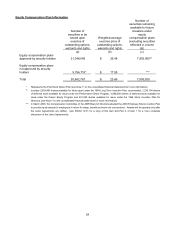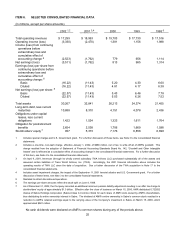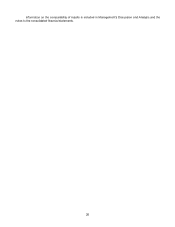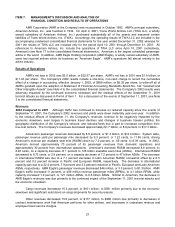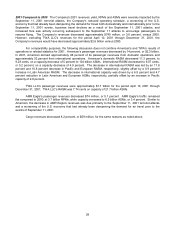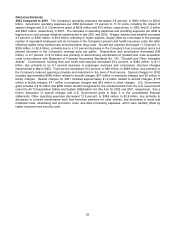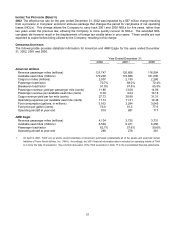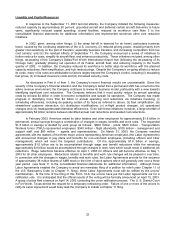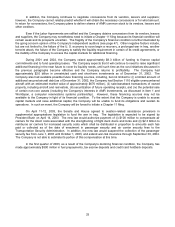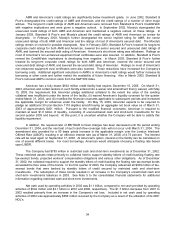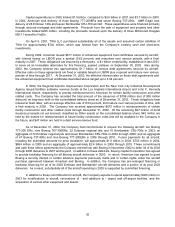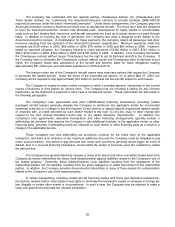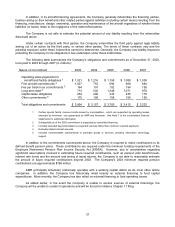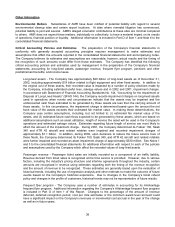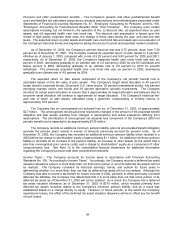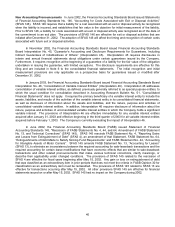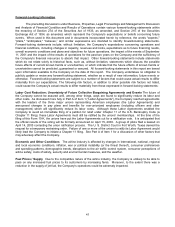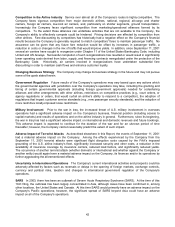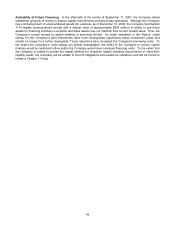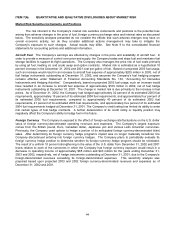American Airlines 2002 Annual Report Download - page 36
Download and view the complete annual report
Please find page 36 of the 2002 American Airlines annual report below. You can navigate through the pages in the report by either clicking on the pages listed below, or by using the keyword search tool below to find specific information within the annual report.34
AMR and American’s credit ratings are significantly below investment grade. In June 2002, Standard &
Poor's downgraded the credit ratings of AMR and American, and the credit ratings of a number of other major
airlines. The long-term credit ratings of AMR and American were removed from Standard & Poor's CreditWatch
with negative implications and were given a negative outlook. In September 2002, Moody's downgraded the
unsecured credit ratings of both AMR and American and maintained a negative outlook on these ratings. In
January 2003, Standard & Poor's and Moody's placed the credit ratings of AMR and American on review for
downgrade. In February 2003, Moody's further downgraded the senior implied rating for AMR, the senior
unsecured ratings of both AMR and American and the ratings of most of American's secured debt. The Moody's
ratings remain on review for possible downgrade. Also in February 2003, Standard & Poor's lowered its long-term
corporate credit ratings for both AMR and American, lowered the senior secured and unsecured debt ratings of
AMR, and lowered the secured debt rating of American. American's short-term rating was withdrawn. Ratings on
most of American's non-enhanced equipment trust certificates were also lowered. In addition, Standard & Poor's
revised the CreditWatch implications to developing from negative. In March 2003, Standard & Poor's further
lowered its long-term corporate credit ratings for both AMR and American, lowered the senior secured and
unsecured debt ratings of AMR, and lowered the secured debt rating of American. Ratings on most of American's
non-enhanced equipment trust certificates were also lowered. These reductions have increased the Company’s
borrowing costs. Additional significant reductions in AMR's or American's credit ratings would further increase its
borrowing or other costs and further restrict the availability of future financing. Also in March 2003, Standard &
Poor’s removed AMR’s common stock from the S&P 500 index.
American has a fully drawn $834 million credit facility that expires December 15, 2005. On March 31,
2003, American and certain lenders in such facility entered into a waiver and amendment that (i) waived, until May
15, 2003, the requirement that American pledge additional collateral to the extent the value of the existing
collateral was insufficient under the terms of the facility, (ii) waived American’s liquidity covenant for the quarter
ended March 31, 2003, and (iii) modified the financial covenants applicable to subsequent periods and increased
the applicable margin for advances under the facility. On May 15, 2003, American expects to be required to
pledge an additional 30 (non-Section 1110 eligible) aircraft having an aggregate net book value as of March 31,
2003 of approximately $451 million. Pursuant to the modified financial covenants, American is required to
maintain at least $1.0 billion of liquidity, consisting of unencumbered cash and short-term investments for the
second quarter 2003 and beyond. At this point, it is uncertain whether the Company will be able to satisfy this
liquidity requirement.
In addition, the required ratio of EBITDAR to fixed charges has been decreased until the period ending
December 31, 2004, and the next test of such cash flow coverage ratio will not occur until March 31, 2004. The
amendment also provided for a 50 basis points increase in the applicable margin over the London Interbank
Offered Rate (LIBOR), resulting in an effective interest rate (as of March 31, 2003) of 4.73 percent. The interest
rate will be reset again on September 17, 2003. At American's option, interest on the facility can be calculated on
one of several different bases. For most borrowings, American would anticipate choosing a floating rate based
upon LIBOR.
The Company had $783 million in restricted cash and short-term investments as of December 31, 2002.
These restricted assets relate primarily to collateral held to support standby letters of credit backing floating rate
tax-exempt bonds, projected workers’ compensation obligations and various other obligations. As of December
31, 2002, the collateral required to support the standby letters of credit backing the floating rate tax-exempt bonds
exceeded the face value of the bonds. In the first quarter of 2003, the Company redeemed all $339 million of tax-
exempt bonds that were backed by standby letters of credit secured by restricted cash and short-term
investments. The redemption of these bonds resulted in an increase in the Company’s unrestricted cash and
short-term investments balances in 2003. See Note 5 to the consolidated financial statements for additional
information regarding restricted cash and short-term investments.
Net cash used by operating activities in 2002 was $1.1 billion, compared to net cash provided by operating
activities of $542 million and $3.1 billion in 2001 and 2000, respectively. The $1.7 billion decrease from 2001 to
2002 resulted primarily from an increase in the Company’s net loss. Included in net cash used by operating
activities of 2002 was approximately $658 million received by the Company as a result of the utilization of its 2001
NOL’s.


